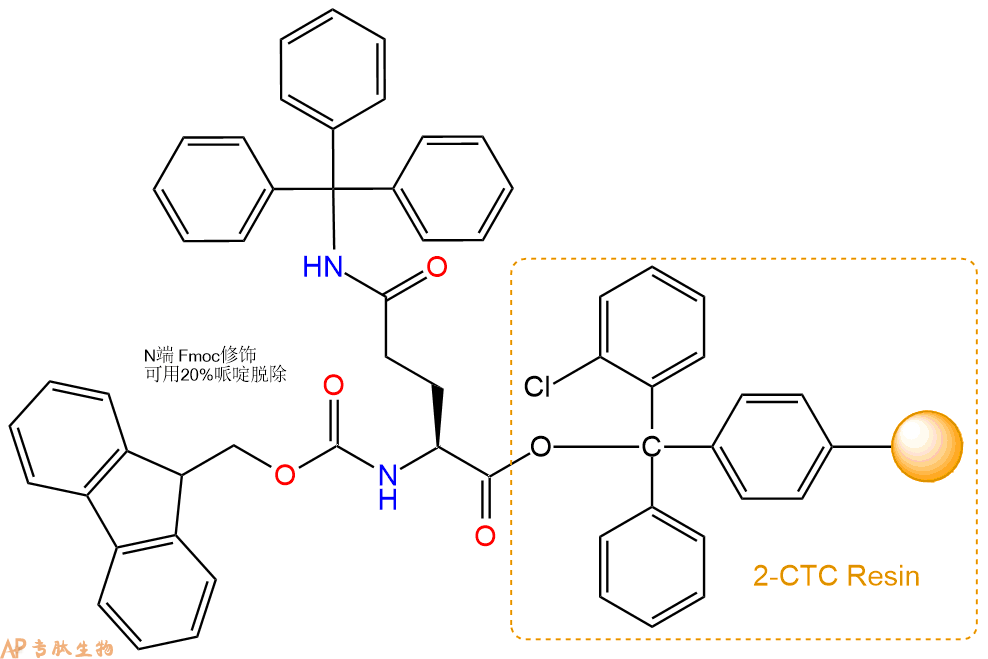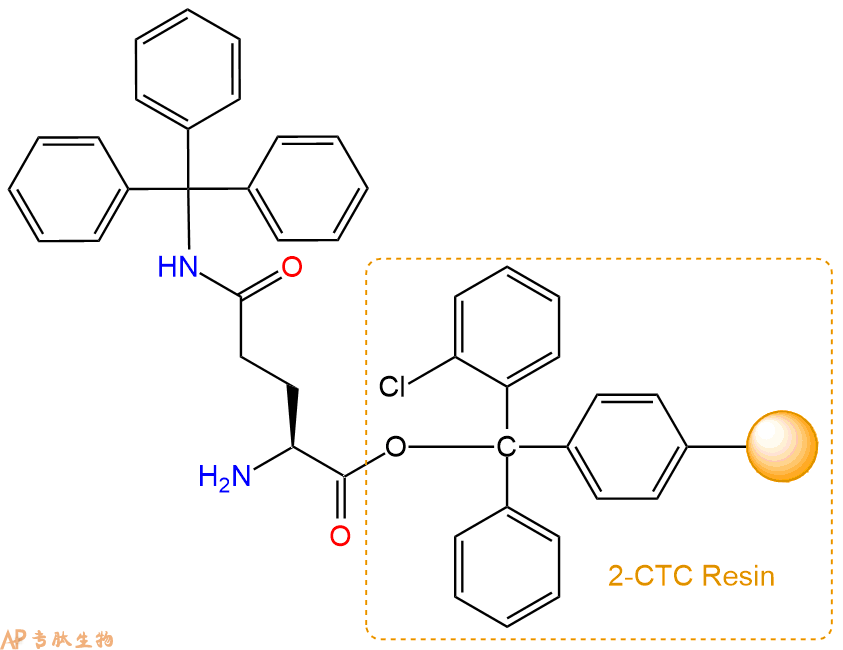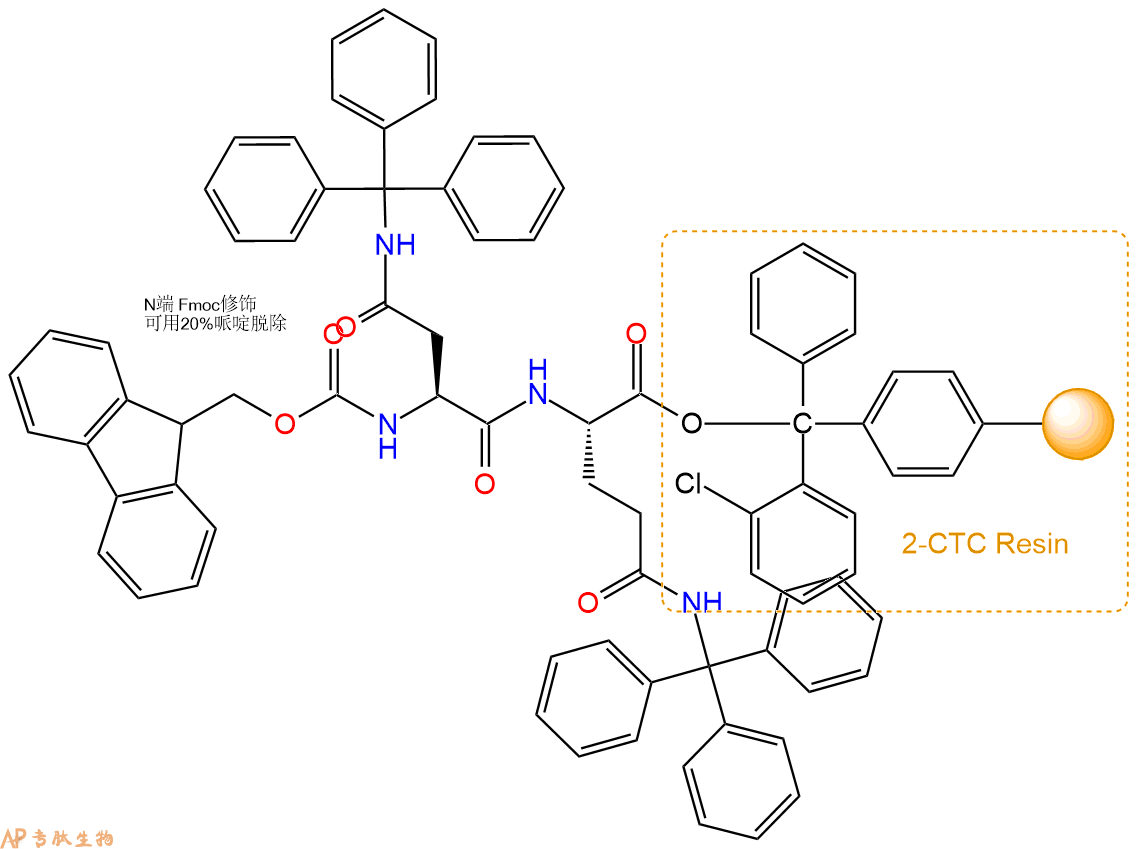
Dynorphin A acetate是一种七肽,来源于前炔诺啡的裂解,广泛分布于中枢神经系统。它作为内源性κ受体激动剂,具有纳摩尔结合亲和力。
编号:114465
CAS号:80448-90-4
单字母:H2N-YGGFLRRIRPKLKWDNQ-OH
| 编号: | 114465 |
| 中文名称: | 强啡肽A(1-17)、Dynorphin A (1 - 17) |
| 中文同义词: | 肌啡肽A |
| 英文名: | Dynorphin A (1 - 17) |
| 英文同义词: | Prodynorphin (209-225) (porcine)、Dynorphin A (human, pig, rat, Bos taurus) |
| CAS号: | 80448-90-4 |
| 单字母: | H2N-YGGFLRRIRPKLKWDNQ-OH |
| 三字母: | H2N N端氨基 -Tyr酪氨酸 -Gly甘氨酸 -Gly甘氨酸 -Phe苯丙氨酸 -Leu亮氨酸 -Arg精氨酸 -Arg精氨酸 -Ile异亮氨酸 -Arg精氨酸 -Pro脯氨酸 -Lys赖氨酸 -Leu亮氨酸 -Lys赖氨酸 -Trp色氨酸 -Asp天冬氨酸 -Asn天冬酰胺 -Gln谷氨酰胺 -OHC端羧基 |
| 氨基酸个数: | 17 |
| 分子式: | C99H155N31O23 |
| 平均分子量: | 2147.48 |
| 精确分子量: | 2146.19 |
| 等电点(PI): | 12.82 |
| pH=7.0时的净电荷数: | 5.97 |
| 平均亲水性: | 0.26428571428571 |
| 疏水性值: | -1.24 |
| 消光系数: | 6990 |
| 来源: | 人工化学合成,仅限科学研究使用,不得用于人体。 |
| 储存条件: | 负80℃至负20℃ |
| 标签: | 激动剂多肽(Agonist Peptide) 强啡肽(Dynorphin) |
Dynorphin A acetate是一种七肽,来源于前炔诺啡的裂解,广泛分布于中枢神经系统。它作为内源性κ受体激动剂,具有纳摩尔结合亲和力。它还激活ORL1的人类新型阿片受体样受体。它对酶降解具有抗性,并可能具有抗伤害的功能。
Dynorphin A acetate is a heptadecapeptide derived from the cleavage of prodynorphin and found widely distributed in the central nervous system. It acts as an endogenous kappa receptor agonist with nanomolar binding affinity. It also activates the human novel opioid receptor-like receptor of ORL1. It is resistant to enzymatic degradation and may have antinociceptive functions.
Definition
Dynorphins are a class of endogenous opioid peptides produced in many different parts of the brain, including the hypothalamus, the hippocampus and the spinal cord, and have many different physiological actions, depending upon the site of production.
Related peptides
Dynorphins arise from the precursor protein prodynorphin. When prodynorphin is cleaved during processing by proprotein convertase 2 (PC2), multiple active peptides are released: dynorphin A, dynorphin B, “big dynorphin” and a/ß-neo-endorphin1.
Discovery
Dynophin was discovered in the mid 1970's in the laboratory of Avram Goldstein, one of the most important researchers in the field of opioid receptors and endogenous opioid peptides. The molecular identification was achieved by Goldstein in collaboration with the Japanese biochemist, Shinro Tachibana for purification, and M. Hunkapiller and L. Hood, who performed the microsequencing.
Structural characteristics
A 4,000-dalton dynorphin (also called the “Big dynorphin”) was isolated from porcine pituitary. It has 32 amino acids, with a heptadecapeptide (17 amino acid sequence), called dynorphin A, at its amino terminus and a related tridecapeptide (13 amino acid sequence), dynorphin B, at its carboxyl terminus. The two peptides are separated by the "processing signal" Lys-Arg2.
Mechanism of action
Dynorphins primarily exert their effects through a G-protein coupled receptor called the ?-opioid receptor (KOR) 3. Although KOR is the primary receptor for all dynorphins, the peptides do have some affinity for the µ-opioid receptor (MOR), d-opioid receptor (DOR), N-methyl-D-aspartic acid (NMDA)-type glutamate receptor, and bradykinin receptor. Different dynorphins show different receptor selectivities and potencies at receptors. Both big dynorphin and dynorphin A are more potent and more selective than dynorphin B. Dynorphin decreases dopamine release by binding to KORs on dopamine nerve terminals, which leads to drug tolerance and withdrawal symptoms.
Functions
Dynorphins modulate pain response. They can significantly inhibit morphine- or beta-endorphin-induced analgesia4. Dynorphins inhibit dopamine release that would counter the pleasurable effects of cocaine5. They are important in maintaining homeostasis through appetite control and circadian rhythms6. In addition to their role in weight control, dynorphins have also been found to regulate body temperature7.
References
1. Day, R., Lazure, C., Basak, A., Boudreault, A., Limperis, P., Dong, W., et al. (1998). Prodynorphin processing by proprotein convertase 2. Cleavage at single basic residues and enhanced processing in the presence of carboxypeptidase activity. J Biol. Chem., 273(2), 829-836.
2. W Fischli, A Goldstein, M W Hunkapiller, and L E Hood (1982). Isolation and amino acid sequence analysis of a 4,000-dalton dynorphin from porcine pituitary. PNAS, 79 (17), 5435-5437.
3. Nyberg, F. & Hallburg, M. (2007). Neuropeptides in hyperthermia. Progress in brain research, 162:277-93.
4. FC Tulunay, MF Jen, JK Chang, HH Loh and NM Lee, (1981). Possible regulatory role of dynorphin on morphine- and beta-endorphin- induced analgesia. American Society for Pharmacology and Experimental Therapeutics, 219 (2), 296-298.
5. Clavin, W. (2005). Dynorphin: Nature’s Own Antidote to Cocaine (and Pleasure?).
6. Przewlocki, R., Lason, W., Konecka, A. M., Gramsch, C., Herz, A., & Reid, L. D. (1983). The opioid peptide dynorphin, circadian rhythms, and starvation. Science, 219(4580), 71-73.
7. Xin, L., Geller, E. B., & Adler, M. W. (1997). Body temperature and analgesic effects of selective mu and kappa opioid receptor agonists microdialyzed into rat brain. Journal of Pharmacology and Experimental Therapeutics, 281(1), 499-507.
Zhang, et al.Dynorphin A as a Potential Endogenous Ligand for Four Members of the Opioid Receptor Gene Family. J Pharmacol Exp Ther. 1998 Jul;286(1):136-41. : https://pubmed.ncbi.nlm.nih.gov/9655852/
多肽H2N-Tyr-Gly-Gly-Phe-Leu-Arg-Arg-Ile-Arg-Pro-Lys-Leu-Lys-Trp-Asp-Asn-Gln-COOH的合成步骤:
1、合成CTC树脂:称取0.36g CTC Resin(如初始取代度约为0.95mmol/g)和0.41mmol Fmoc-Gln(Trt)-OH于反应器中,加入适量DCM溶解氨基酸(需要注意,此时CTC树脂体积会增大好几倍,避免DCM溶液过少),再加入1.03mmol DIPEA(Mw:129.1,d:0.740g/ml),反应2-3小时后,可不抽滤溶液,直接加入1ml的HPLC级甲醇,封端半小时。依次用DMF洗涤2次,甲醇洗涤1次,DCM洗涤一次,甲醇洗涤一次,DCM洗涤一次,DMF洗涤2次(这里使用甲醇和DCM交替洗涤,是为了更好地去除其他溶质,有利于后续反应)。得到 Fmoc-Gln(Trt)-CTC Resin。结构图如下:

2、脱Fmoc:加3倍树脂体积的20%Pip/DMF溶液,鼓氮气30分钟,然后2倍树脂体积的DMF 洗涤5次。得到 H2N-Gln(Trt)-CTC Resin 。(此步骤脱除Fmoc基团,茚三酮检测为蓝色,Pip为哌啶)。结构图如下:

3、缩合:取1.03mmol Fmoc-Asn(Trt)-OH 氨基酸,加入到上述树脂里,加适当DMF溶解氨基酸,再依次加入2.05mmol DIPEA,0.97mmol HBTU。反应30分钟后,取小样洗涤,茚三酮检测为无色。用2倍树脂体积的DMF 洗涤3次树脂。(洗涤树脂,去掉残留溶剂,为下一步反应做准备)。得到Fmoc-Asn(Trt)-Gln(Trt)-CTC Resin。氨基酸:DIPEA:HBTU:树脂=3:6:2.85:1(摩尔比)。结构图如下:

4、依次循环步骤二、步骤三,依次得到
H2N-Asn(Trt)-Gln(Trt)-CTC Resin
Fmoc-Asp(OtBu)-Asn(Trt)-Gln(Trt)-CTC Resin
H2N-Asp(OtBu)-Asn(Trt)-Gln(Trt)-CTC Resin
Fmoc-Trp(Boc)-Asp(OtBu)-Asn(Trt)-Gln(Trt)-CTC Resin
H2N-Trp(Boc)-Asp(OtBu)-Asn(Trt)-Gln(Trt)-CTC Resin
Fmoc-Lys(Boc)-Trp(Boc)-Asp(OtBu)-Asn(Trt)-Gln(Trt)-CTC Resin
H2N-Lys(Boc)-Trp(Boc)-Asp(OtBu)-Asn(Trt)-Gln(Trt)-CTC Resin
Fmoc-Leu-Lys(Boc)-Trp(Boc)-Asp(OtBu)-Asn(Trt)-Gln(Trt)-CTC Resin
H2N-Leu-Lys(Boc)-Trp(Boc)-Asp(OtBu)-Asn(Trt)-Gln(Trt)-CTC Resin
Fmoc-Lys(Boc)-Leu-Lys(Boc)-Trp(Boc)-Asp(OtBu)-Asn(Trt)-Gln(Trt)-CTC Resin
H2N-Lys(Boc)-Leu-Lys(Boc)-Trp(Boc)-Asp(OtBu)-Asn(Trt)-Gln(Trt)-CTC Resin
Fmoc-Pro-Lys(Boc)-Leu-Lys(Boc)-Trp(Boc)-Asp(OtBu)-Asn(Trt)-Gln(Trt)-CTC Resin
H2N-Pro-Lys(Boc)-Leu-Lys(Boc)-Trp(Boc)-Asp(OtBu)-Asn(Trt)-Gln(Trt)-CTC Resin
Fmoc-Arg(Pbf)-Pro-Lys(Boc)-Leu-Lys(Boc)-Trp(Boc)-Asp(OtBu)-Asn(Trt)-Gln(Trt)-CTC Resin
H2N-Arg(Pbf)-Pro-Lys(Boc)-Leu-Lys(Boc)-Trp(Boc)-Asp(OtBu)-Asn(Trt)-Gln(Trt)-CTC Resin
Fmoc-Ile-Arg(Pbf)-Pro-Lys(Boc)-Leu-Lys(Boc)-Trp(Boc)-Asp(OtBu)-Asn(Trt)-Gln(Trt)-CTC Resin
H2N-Ile-Arg(Pbf)-Pro-Lys(Boc)-Leu-Lys(Boc)-Trp(Boc)-Asp(OtBu)-Asn(Trt)-Gln(Trt)-CTC Resin
Fmoc-Arg(Pbf)-Ile-Arg(Pbf)-Pro-Lys(Boc)-Leu-Lys(Boc)-Trp(Boc)-Asp(OtBu)-Asn(Trt)-Gln(Trt)-CTC Resin
H2N-Arg(Pbf)-Ile-Arg(Pbf)-Pro-Lys(Boc)-Leu-Lys(Boc)-Trp(Boc)-Asp(OtBu)-Asn(Trt)-Gln(Trt)-CTC Resin
Fmoc-Arg(Pbf)-Arg(Pbf)-Ile-Arg(Pbf)-Pro-Lys(Boc)-Leu-Lys(Boc)-Trp(Boc)-Asp(OtBu)-Asn(Trt)-Gln(Trt)-CTC Resin
H2N-Arg(Pbf)-Arg(Pbf)-Ile-Arg(Pbf)-Pro-Lys(Boc)-Leu-Lys(Boc)-Trp(Boc)-Asp(OtBu)-Asn(Trt)-Gln(Trt)-CTC Resin
Fmoc-Leu-Arg(Pbf)-Arg(Pbf)-Ile-Arg(Pbf)-Pro-Lys(Boc)-Leu-Lys(Boc)-Trp(Boc)-Asp(OtBu)-Asn(Trt)-Gln(Trt)-CTC Resin
H2N-Leu-Arg(Pbf)-Arg(Pbf)-Ile-Arg(Pbf)-Pro-Lys(Boc)-Leu-Lys(Boc)-Trp(Boc)-Asp(OtBu)-Asn(Trt)-Gln(Trt)-CTC Resin
Fmoc-Phe-Leu-Arg(Pbf)-Arg(Pbf)-Ile-Arg(Pbf)-Pro-Lys(Boc)-Leu-Lys(Boc)-Trp(Boc)-Asp(OtBu)-Asn(Trt)-Gln(Trt)-CTC Resin
H2N-Phe-Leu-Arg(Pbf)-Arg(Pbf)-Ile-Arg(Pbf)-Pro-Lys(Boc)-Leu-Lys(Boc)-Trp(Boc)-Asp(OtBu)-Asn(Trt)-Gln(Trt)-CTC Resin
Fmoc-Gly-Phe-Leu-Arg(Pbf)-Arg(Pbf)-Ile-Arg(Pbf)-Pro-Lys(Boc)-Leu-Lys(Boc)-Trp(Boc)-Asp(OtBu)-Asn(Trt)-Gln(Trt)-CTC Resin
H2N-Gly-Phe-Leu-Arg(Pbf)-Arg(Pbf)-Ile-Arg(Pbf)-Pro-Lys(Boc)-Leu-Lys(Boc)-Trp(Boc)-Asp(OtBu)-Asn(Trt)-Gln(Trt)-CTC Resin
Fmoc-Gly-Gly-Phe-Leu-Arg(Pbf)-Arg(Pbf)-Ile-Arg(Pbf)-Pro-Lys(Boc)-Leu-Lys(Boc)-Trp(Boc)-Asp(OtBu)-Asn(Trt)-Gln(Trt)-CTC Resin
H2N-Gly-Gly-Phe-Leu-Arg(Pbf)-Arg(Pbf)-Ile-Arg(Pbf)-Pro-Lys(Boc)-Leu-Lys(Boc)-Trp(Boc)-Asp(OtBu)-Asn(Trt)-Gln(Trt)-CTC Resin
Fmoc-Tyr(tBu)-Gly-Gly-Phe-Leu-Arg(Pbf)-Arg(Pbf)-Ile-Arg(Pbf)-Pro-Lys(Boc)-Leu-Lys(Boc)-Trp(Boc)-Asp(OtBu)-Asn(Trt)-Gln(Trt)-CTC Resin
以上中间结构,均可在专肽生物多肽计算器-多肽结构计算器中,一键画出。
最后再经过步骤二得到 H2N-Tyr(tBu)-Gly-Gly-Phe-Leu-Arg(Pbf)-Arg(Pbf)-Ile-Arg(Pbf)-Pro-Lys(Boc)-Leu-Lys(Boc)-Trp(Boc)-Asp(OtBu)-Asn(Trt)-Gln(Trt)-CTC Resin,结构如下:

5、切割:6倍树脂体积的切割液(或每1g树脂加8ml左右的切割液),摇床摇晃 2小时,过滤掉树脂,用冰无水乙醚沉淀滤液,并用冰无水乙醚洗涤沉淀物3次,最后将沉淀物放真空干燥釜中,常温干燥24小试,得到粗品H2N-Tyr-Gly-Gly-Phe-Leu-Arg-Arg-Ile-Arg-Pro-Lys-Leu-Lys-Trp-Asp-Asn-Gln-COOH。结构图见产品结构图。
切割液选择:1)TFA:H2O=95%:5%
2)TFA:H2O:TIS=95%:2.5%:2.5%
3)三氟乙酸:茴香硫醚:1,2-乙二硫醇:苯酚:水=87.5%:5%:2.5%:2.5%:2.5%
(前两种适合没有容易氧化的氨基酸,例如Trp、Cys、Met。第三种适合几乎所有的序列。)
6、纯化冻干:使用液相色谱纯化,收集目标峰液体,进行冻干,获得蓬松的粉末状固体多肽。不过这时要取小样复测下纯度 是否目标纯度。
7、最后总结:
杭州专肽生物技术有限公司(ALLPEPTIDE https://www.allpeptide.com)主营定制多肽合成业务,提供各类长肽,短肽,环肽,提供各类修饰肽,如:荧光标记修饰(CY3、CY5、CY5.5、CY7、FAM、FITC、Rhodamine B、TAMRA等),功能基团修饰肽(叠氮、炔基、DBCO、DOTA、NOTA等),同位素标记肽(N15、C13),订书肽(Stapled Peptide),脂肪酸修饰肽(Pal、Myr、Ste),磷酸化修饰肽(P-Ser、P-Thr、P-Tyr),环肽(酰胺键环肽、一对或者多对二硫键环),生物素标记肽,PEG修饰肽,甲基化修饰肽等。
以上所有内容,为专肽生物原创内容,请勿发布到其他网站上。





